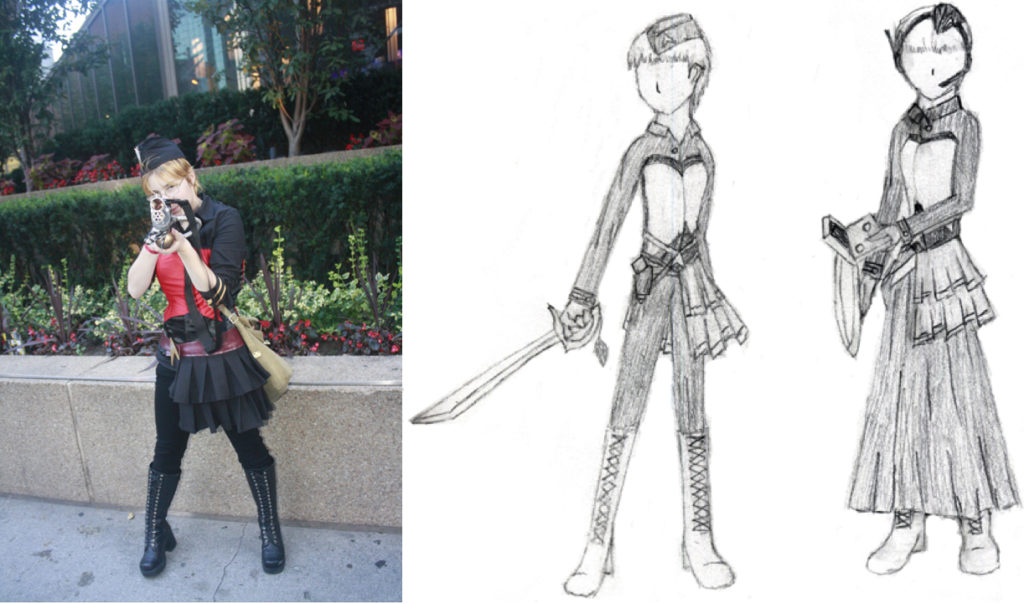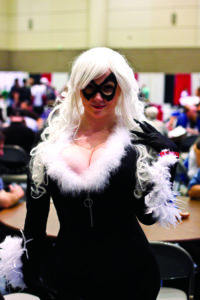The cosplay (costume play) scene at FanExpo is an art that involves hours of toil and blending pop culture with personal accents
Sarah Ciantar
Arts Editor

Amidst the sizable crowd and bustling environment at FanExpo, a costume made of Yu-Gi-Oh! cards punctuates the landscape. Layers of cards are fashioned together in an hourglass shape, a creation artist Kaitlyn Legge calls “The Heart of Cards.”
Accompanied by a matching staff and headpiece, each made of a formation of cards and other materials, Legge’s inventive costume resuscitates the nostalgic memory of Yu-Gi-Oh!
Cosplay, short for “costume play,” is playing dress-up for adults, particularly as ethier a character or a theme from a specific genre of pop culture.
The origins of cosplay, like many of its character inspirations, link back to Japanese culture. Cosplay was created and brought to North America by Nobuyuki Takahashi, when he first put the term to use in a Japanese magazine in 1983. Thanks to the internet, the cosplay scene expanded in large quantities.
The creation process of cosplay is not so different from other artistic media.
“Any artist has a sketchbook full of stuff and samples of their work,” says Sarah Voisin, film studies major at York and cosplay fanatic. “Cosplayers are no different; they experience the creative process and work with their sketches until they get it right.”
Voisin herself has pages upon pages of rough sketches in her notebook of would-be costumes.
Sketching, preparing, and planning unites cosplay to all aspects of art. An imaginative spark creates an idea; sketching allows the artist to play with the details until they are satisfied.
Just as in any other art form, cosplayers primarily focus on trying different things until they get it right and finding an approach that works.
The process begins with collecting materials to match the reference you are rendering. For more intricate pieces, Voisin suggests creating a test costume with scraps of fabrics as it allows the artist to get a feel for the creation. Voisin adds that the creative process “changes depending on the person and the costume.”

By engaging in fantasy, individuals are able to interact with superheroes or other fictional characters. Cosplay enables fans to role-play alongside their favourite characters.
For many, the cosplay experience is artistically personal, an opportunity to produce unique costumes.
“Many people play with their own original ideas for cosplay,” explains Voisin. “It’s about embracing a theme or spirit of a common element of pop culture.”
This approach to cosplay allows an individual to take on a character and make it their own. The spirit of the character is expressed through recognizable landmarks, but unique qualities are also evident, making it one of a kind.
Legge hones in on this creative approach with her inventive costume. Although, technically there is no specific character in Yu-Gi-Oh! by this description, the essence of her costume was still easily recognizable.
The cosplay culture is alluring for its creative, hands-on techniques, allowing you the freedom to unleash your imagination.
“Cosplay is about how you interpret the character and take on the details,” Legge explains, referencing her own unique take on her Yu-Gi-Oh! cosplay.
Inspiration for costumes can also be found in the designs and patterns of the materials you are attracted to. Pieces of fabric and materials are one starting point for its creation. Like Legge’s costume, centered on the material makeup consisting of Yu-Gi-Oh! cards, others too find ideas in materials they are attracted to.
Details, patterns, textures, and vibrant colours attract cosplayers in the same way that any other artist is inspired by their media of choice. Like painters in a paint store, cosplayers are filled with a bevy of ideas and possibilities.
Cosplay is a way for people to embrace the character and expand on other people’s artistic creations.
“It’s just like any art that feeds into itself,” says Voisin. “Like a piece of music can inspire a piece of writing; it’s the same for designing costumes.”

Voisin says cosplayers are the same as professional artists; they have a craft, and they present it to the public.
Then there are the other cosplayers, those who buy their costumes. For many, this can be seen as taking the fun out of the experience.
“Just as much creativity goes into the costumes that were bought,” says Voisin. “There is an artist involved who has a craft and does commissions.”
Legge and Voisin both say bringing the character to life is essential to the art form, and creating something from nothing is what keeps cosplay fun.
While there are different approaches, the creative elements of cosplay keep the conventions popular.


